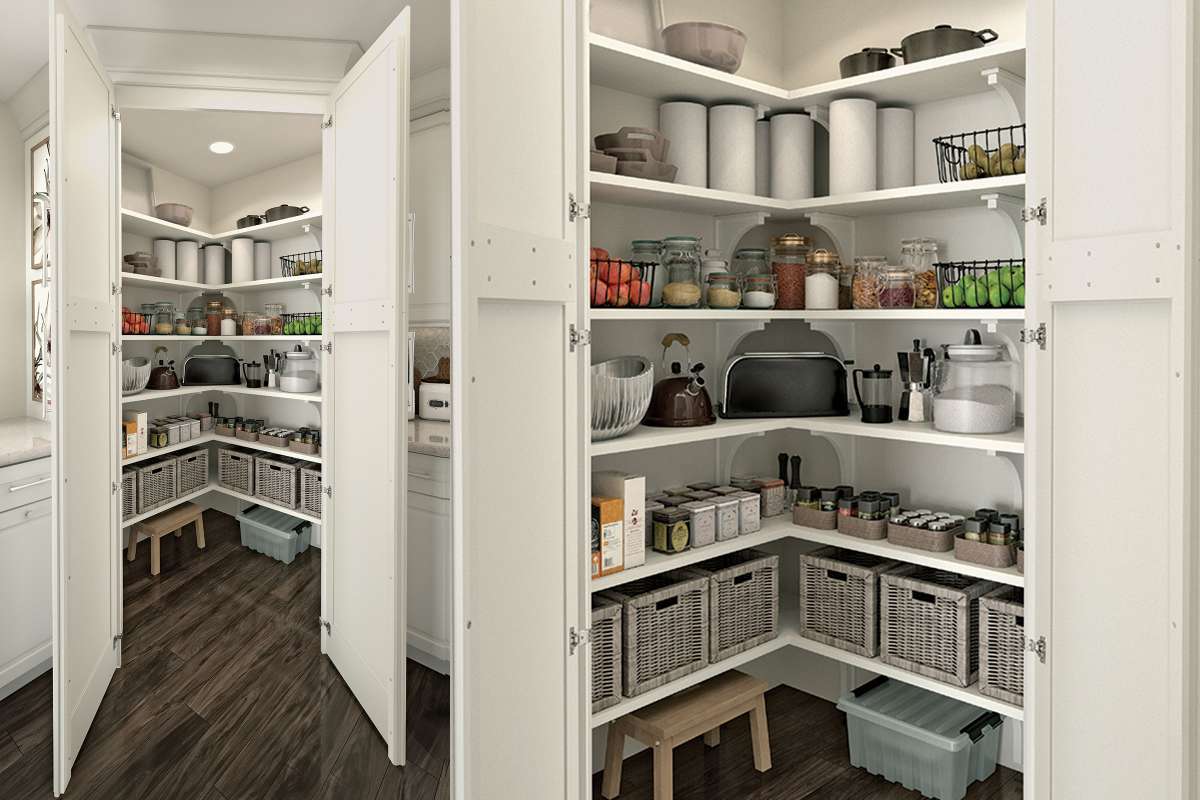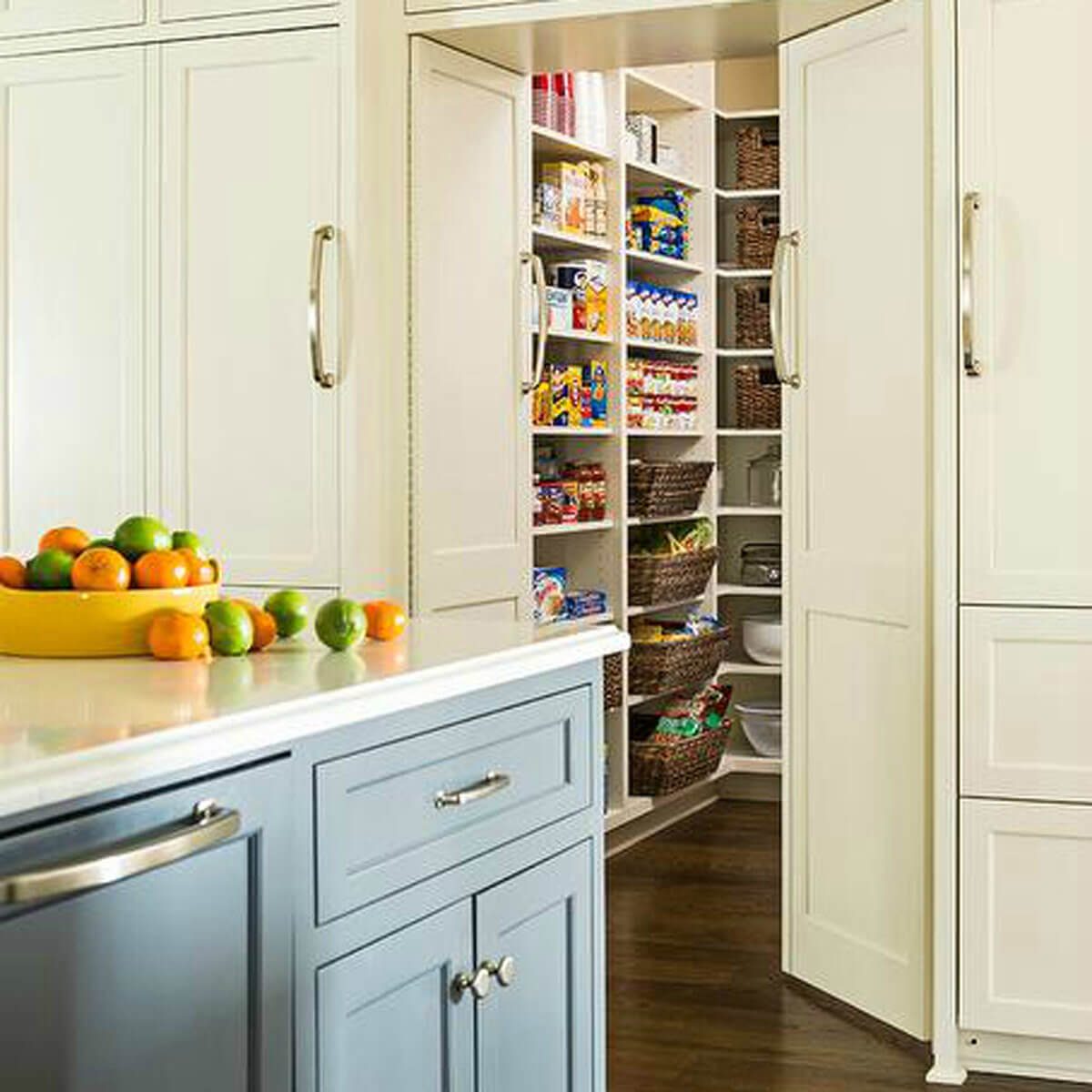Planning and Design Considerations

A built-in pantry cabinet can be a game-changer for your kitchen, offering a dedicated space to organize and store your food and kitchen supplies. However, planning and designing this element requires careful consideration to ensure it meets your needs and enhances the overall functionality of your kitchen.
Advantages and Disadvantages
Incorporating a built-in pantry cabinet into your kitchen design offers several advantages, but it also comes with certain disadvantages. Weighing these factors will help you determine if this feature aligns with your kitchen goals.
- Advantages:
- Increased Storage Space: Built-in pantries provide a dedicated and organized space for storing a wide variety of items, maximizing your kitchen’s storage capacity. This helps eliminate clutter and create a more streamlined and efficient workspace.
- Improved Organization: The structured design of a built-in pantry allows for easy categorization and organization of food and supplies. This makes it simpler to find what you need and reduces the likelihood of items getting lost or forgotten.
- Enhanced Aesthetics: A well-designed built-in pantry can seamlessly integrate with your kitchen’s aesthetic, adding a touch of elegance and sophistication while providing a functional storage solution.
- Durable and Long-Lasting: Built-in pantries are typically constructed from high-quality materials, making them durable and long-lasting, capable of withstanding the wear and tear of everyday use.
- Disadvantages:
- Cost: Building a custom pantry cabinet can be more expensive than purchasing a standalone pantry. This cost can vary depending on the size, materials, and complexity of the design.
- Space Requirements: A built-in pantry needs dedicated space within your kitchen layout, which may limit the available space for other appliances or furniture. Carefully consider the dimensions and layout of your kitchen before committing to a built-in pantry.
- Limited Flexibility: Once a built-in pantry is installed, it’s generally not easy to adjust or relocate. This lack of flexibility can be a consideration if your storage needs may change over time.
Construction and Installation: Built In Pantry Cabinet Ideas

Building a built-in pantry cabinet requires careful planning and execution. You’ll need to consider the materials, framing, shelving, and finishing, along with important factors like ventilation and structural integrity.
Materials for Built-in Pantry Cabinets
The choice of materials for your built-in pantry cabinet depends on your budget, desired aesthetic, and the specific needs of your kitchen. Here’s a breakdown of common materials and their pros and cons:
- Plywood: A versatile and durable option, plywood is commonly used for cabinet construction. It’s readily available in various thicknesses and finishes, making it adaptable to different designs. Plywood is generally more affordable than solid wood and offers good resistance to warping and moisture. However, it may not be as visually appealing as solid wood.
- Solid Wood: Solid wood, such as maple, cherry, or oak, adds a touch of elegance and warmth to a kitchen. It’s known for its durability and beautiful grain patterns. However, solid wood can be more expensive than plywood and is susceptible to warping and cracking if not properly treated and cared for. Solid wood is a great option for those who prioritize a natural and sophisticated look.
- Medium-Density Fiberboard (MDF): MDF is a cost-effective option that offers a smooth, consistent surface. It’s ideal for painting or laminating. However, MDF is not as durable as plywood or solid wood and can be susceptible to moisture damage. MDF is a good choice for budget-conscious projects where a smooth finish is desired.
- Particleboard: Particleboard is the least expensive option, but it’s also the least durable. It’s prone to chipping and warping and is not suitable for areas exposed to moisture. Particleboard is best used for concealed areas where strength and durability are not major concerns.
Framing and Installation
Framing the structure of your built-in pantry cabinet is crucial for stability and support. It’s a process that involves creating a sturdy framework to hold the shelves and doors.
- Measure and Mark: Start by accurately measuring the space where you want to install the pantry cabinet. Use a level to ensure all walls are plumb and straight. Mark the dimensions on the walls using a pencil and a tape measure.
- Build the Framework: Use 2×4 studs to build the framework for your cabinet. Cut the studs to the desired lengths and secure them together using wood glue and screws. Make sure the frame is square and level. You can use a framing square and level to ensure accuracy.
- Attach to Walls: Attach the framework to the walls using screws or nails. Make sure the screws or nails are long enough to penetrate the wall studs for secure attachment. You can use a stud finder to locate the studs for accurate placement.
- Install Shelves: Once the frame is in place, install the shelves. You can use pre-made shelves or create your own using plywood or solid wood. Secure the shelves to the frame using brackets or shelf pins. Make sure the shelves are level and evenly spaced.
- Add Doors: Install the doors to your pantry cabinet. You can choose from various styles and materials, such as solid wood, glass, or a combination of both. Use hinges to attach the doors to the frame and ensure they open and close smoothly. You can add handles or knobs for ease of access.
Ventilation and Moisture Control, Built in pantry cabinet ideas
Proper ventilation and moisture control are essential for preventing mold growth and preserving food in your pantry cabinet.
Ventilation: Ensure adequate airflow within the cabinet by leaving a small gap between the back of the cabinet and the wall. This allows air to circulate and prevents moisture buildup. You can also install a small vent in the back of the cabinet to enhance ventilation.
Moisture Control: Use moisture-resistant materials for construction, such as plywood or solid wood treated with a sealant. You can also install a dehumidifier inside the cabinet to absorb excess moisture.
Structural Integrity and Stability
A sturdy and well-constructed built-in pantry cabinet will last for years. Here are some tips for ensuring its structural integrity and stability:
- Use Quality Materials: Choose durable and moisture-resistant materials like plywood or solid wood for the cabinet construction. Avoid using particleboard or MDF in areas exposed to moisture.
- Secure Framing: Use screws or nails to securely attach the framework to the walls and to each other. Make sure the screws or nails are long enough to penetrate the wall studs and provide adequate support.
- Reinforce Corners: Reinforce the corners of the cabinet by adding additional bracing or corner blocks. This helps to prevent the cabinet from sagging or becoming unstable over time.
- Properly Support Shelves: Use sturdy shelf brackets or shelf pins to support the weight of your pantry items. Make sure the brackets or pins are properly installed and secured to the frame.
Organization and Storage Solutions
A well-organized pantry is the key to a streamlined kitchen. It allows for easy access to all your food items, reduces waste, and makes meal planning a breeze. With a built-in pantry cabinet, you have the perfect canvas to create a customized storage system that meets your specific needs.
Designing a Storage System
Creating a functional and visually appealing pantry starts with thoughtful planning. The first step is to categorize your food items. This will help you determine the best storage solutions for each category. Consider these common pantry categories:
- Dry Goods: These include items like pasta, rice, grains, flour, sugar, and baking supplies. Store these items in airtight containers to protect them from moisture and pests.
- Canned Goods: Canned fruits, vegetables, soups, and beans are pantry staples. Organize them by type or by expiration date for easy access and to minimize waste.
- Perishable Items: This category includes items like fruits, vegetables, and dairy products that need to be refrigerated or stored in a cool, dry place. Utilize designated areas within the pantry for these items, ensuring they are easily accessible and stored at the appropriate temperature.
- Snacks: Keep snacks readily available for quick and easy access. Consider storing them in clear bins or baskets for visibility.
- Spices and Condiments: Organize spices and condiments by category or alphabetically for easy retrieval. Use a tiered spice rack or drawer organizer to maximize space and visibility.
Maximizing Storage Space
With a little creativity, you can maximize the storage space within your built-in pantry cabinet. Here are some innovative solutions:
- Pull-out Shelves: These shelves slide out smoothly, making it easy to access items stored in the back. They are ideal for storing heavy items like canned goods or jars.
- Lazy Susans: Lazy Susans are perfect for storing spices, condiments, or canned goods. They rotate, allowing you to easily access everything without having to move items around.
- Dividers: Dividers can be used to create separate compartments within shelves or drawers, allowing you to neatly organize different categories of items. This is especially useful for storing items like snacks, baking supplies, or utensils.
- Vertical Storage: Utilize vertical space by installing shelves or racks above the counter. This is a great way to store items that are not frequently used.
Creating a Visually Appealing Pantry
A well-organized pantry should not only be functional but also visually appealing. Here are some tips for achieving this:
- Labeling: Use clear labels to identify the contents of each container or bin. This will make it easy to find what you need and keep your pantry organized.
- Color-Coding: Consider color-coding your containers or bins to further enhance organization. For example, you could use blue for snacks, green for fruits and vegetables, and red for canned goods.
- Clear Containers: Use clear containers for storing dry goods, snacks, and other items. This allows you to easily see what you have and prevents you from buying duplicates.
Benefits of Specific Storage Solutions
- Bins: Bins are great for storing larger items like snacks, baking supplies, or canned goods. They can be stacked or placed side-by-side to maximize space.
- Baskets: Baskets are a versatile storage solution for a variety of items, from fruits and vegetables to snacks and linens. They can be used to create a decorative element within the pantry.
- Drawer Organizers: Drawer organizers are ideal for keeping smaller items, such as spices, condiments, or utensils, organized and easily accessible.
Built in pantry cabinet ideas – The art of creating a built-in pantry cabinet lies in maximizing every inch of space. For a sleek and efficient solution, consider incorporating a 36 inch metal cabinet as the core element. Its sturdy construction and adaptable design allow for seamless integration into your pantry’s layout, creating a harmonious flow of energy and organization within this essential space.
Built-in pantry cabinets offer a sanctuary for your culinary treasures, allowing you to organize and access ingredients with ease. For those seeking a similar sense of order in their wardrobe, consider the transformative power of an 8 cabinet multi storage wardrobe.
Just as a well-stocked pantry nourishes the body, a meticulously organized wardrobe feeds the soul, providing a sense of calm and clarity. With both, you’ll find that a space thoughtfully designed for storage becomes a haven of peace and abundance.